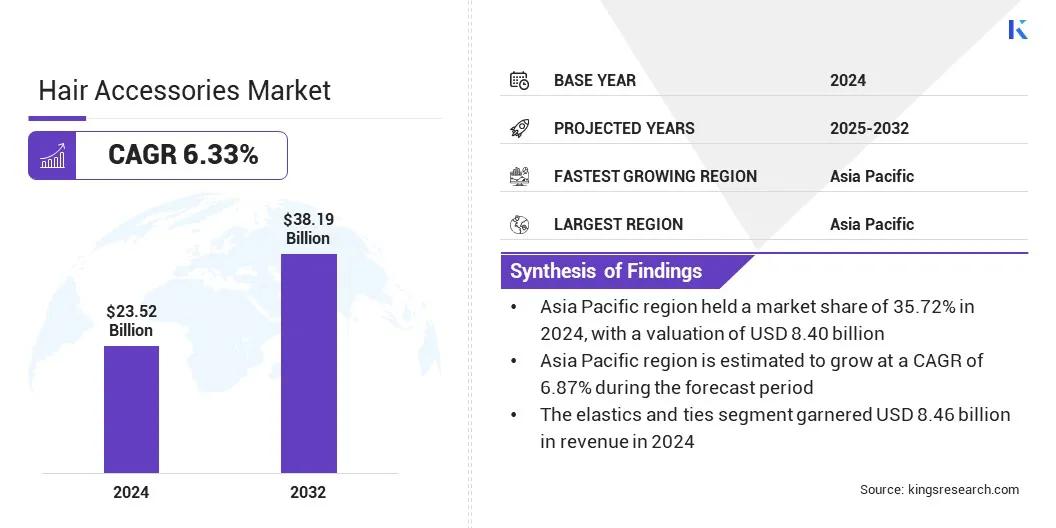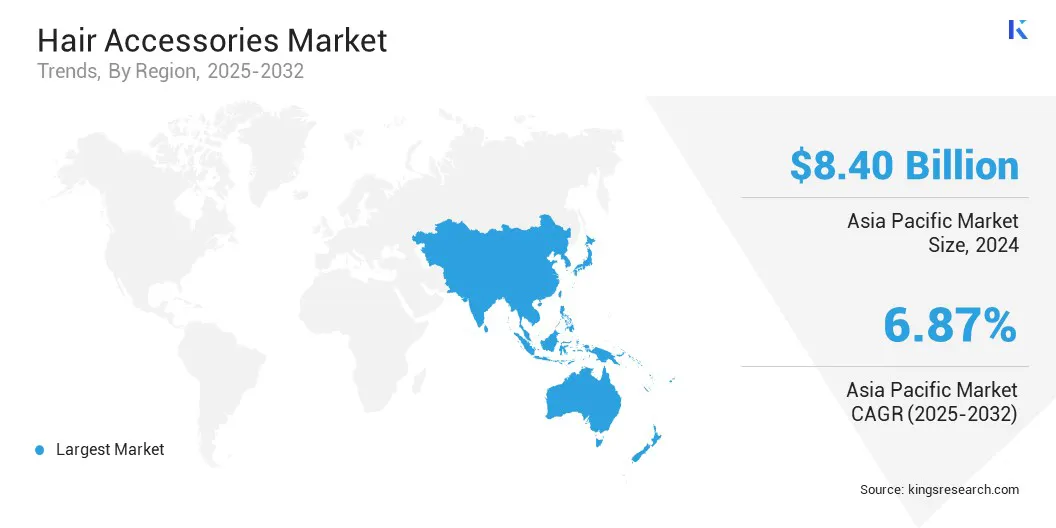Market Definition
Hair accessories are functional and decorative items designed to hold, style, or embellish hair, including clips, bands, pins, barrettes, combs, and headbands. The market covers products made from plastic, metal, fabric, and sustainable materials, sold through online and offline retail channels.
It includes mass-market and premium segments, catering to daily use, fashion styling, and cultural expression across all age groups. The market scope spans personal grooming, beauty enhancement, and occasion-based styling across global demographics.
Hair Accessories Market Overview
The global hair accessories market size was valued at USD 23.52 billion in 2024 and is projected to grow from USD 24.85 billion in 2025 to USD 38.19 billion by 2032, exhibiting a CAGR of 6.33% during the forecast period.
The market growth is attributed to growing consumer preference for functionality and wearability in hair accessories. Additionally, the market is expanding due to the increasing preference for sustainable and eco-conscious wigs among environmentally conscious consumers.
Key Highlights:
- The hair accessories industry size was valued at USD 23.52 billion in 2024.
- The market is projected to grow at a CAGR of 6.33% from 2025 to 2032.
- Asia Pacific held a market share of 35.72% in 2024, with a valuation of USD 8.40 billion.
- The elastics and ties segment garnered USD 8.46 billion in revenue in 2024.
- The plastic segment is expected to reach USD 13.80 billion by 2032.
- The online retailers segment is anticipated to register the fastest CAGR of 7.73% during the forecast period.
- The market in Europe is anticipated to grow at a CAGR of 6.51% during the forecast period.
Major companies operating in the hair accessories industry are Goody, Conair LLC, CBI Distributing Corp., H & M Hennes & Mauritz AB., Fromm International, Annie International, Inc., SILKE London, HAIRDRAMACO INDIA PRIVATE LIMITED, Bunzee Bands, Jennifer Behr LLC, Lele Sadoughi., PuffCuff, LLC, S ta-Rite Ginnie Lou., Novita Boutique, and EVITA PERONI OFFICIAL.

Social media platforms and celebrity endorsements are playing a key role in shaping the consumer demand for fashionable and eye-catching hair accessories. Influencers and celebrities regularly showcase these products across Instagram, TikTok, and YouTube, significantly increasing their visibility.
This exposure creates aspirational value and accelerates trend adoption, as consumers seek to replicate the styles promoted by public figures. The influence of digital content continues to strengthen purchasing decisions and shape preferences within the market.
- In February 2025, Joico named Kate Hudson as its first global celebrity spokesperson, launching a campaign across digital, print, and in-store channels in North America to leverage her broad appeal and influence consumer preferences in hair care and styling.
Market Driver
Growing Consumer Preference for Functionality and Wearability
The rising demand for comfortable and secure hair accessories is driving the market by shaping consumer preferences around functionality, ease of use, and long-lasting wear. Buyers seek accessories that provide a firm hold without pulling, slipping, or causing discomfort, especially during daily routines or physical activity.
This demand is influencing product development priorities and reshaping purchasing behavior, leading to higher adoption rates. The market is expanding across age groups and diverse usage occasions.
- In February 2024, GIMME Beauty launched its Double Claw Clip Duo, featuring a double-row grip design and velvet finish for secure, all-day hold, reduced tension, and breakage-free styling for all hair types.
Market Challenge
Price Competition from Unbranded and Low-cost Alternatives
Intense competition from unbranded and low-cost products presents a key challenge in the hair accessories market by creating pricing pressure and limiting brand differentiation. These products often replicate popular designs at lower prices, reducing the perceived value of premium offerings. This dynamic affects consumer loyalty and disrupts revenue growth for established players, particularly in price-sensitive markets.
Manufacturers are focusing on product innovation, quality enhancement, and brand positioning through targeted marketing. By emphasizing unique features and durability, brands aim to reinforce value perception and maintain competitive relevance within an increasingly fragmented market landscape.
Market Trend
Growing Preference for Sustainable and Eco-conscious Wigs
An emerging trend in the hair accessories market is the growing preference for sustainable wigs, influenced by heightened consumer awareness of ethical sourcing and environmental impact. Consumers are opting for wigs made from recycled synthetics, responsibly sourced human hair, and plant-based materials.
In line with this shift, brands are adopting eco-conscious manufacturing, biodegradable packaging, and circular design approaches. This trend is guiding product development toward sustainability, reflecting a broader alignment with evolving consumer values and expectations.
- In June 2025, Fysin Hair launched a new lace-front wig collection focused on quality and sustainability. The collection features ethically sourced materials and eco-friendly packaging, aligning with the market's shift toward responsible beauty products.
Hair Accessories Market Report Snapshot
|
Segmentation
|
Details
|
|
By Product Type
|
Clips and Pins, Headbands, Wigs and Extensions, Elastics and Ties
|
|
By Material
|
Fabric, Plastic, Metal
|
|
By Distribution Channel
|
Supermarkets & Hypermarkets, Specialty Stores, Salons & Beauty Parlors, Online Retailers
|
|
By Region
|
North America: U.S., Canada, Mexico
|
|
Europe: France, UK, Spain, Germany, Italy, Russia, Rest of Europe
|
|
Asia-Pacific: China, Japan, India, Australia, ASEAN, South Korea, Rest of Asia-Pacific
|
|
Middle East & Africa: Turkey, U.A.E., Saudi Arabia, South Africa, Rest of Middle East & Africa
|
|
South America: Brazil, Argentina, Rest of South America
|
Market Segmentation:
- By Product Type (Clips and Pins, Headbands, Wigs and Extensions, and Elastics and Ties): The elastics and ties segment earned USD 8.46 billion in 2024, due to its high usage frequency, affordability, and broad consumer appeal across age groups and hair types.
- By Material (Fabric, Plastic, and Metal): The plastic segment held 38.61% share of the market in 2024, due to its low production cost, design versatility, and wide availability across both premium and mass-market retail channels.
- By Distribution Channel (Supermarkets & Hypermarkets, Specialty Stores, Salons & Beauty Parlors, and Online Retailers): The specialty stores segment is projected to reach USD 13.46 billion by 2032, owing to its curated product offerings, personalized shopping experience, and strong consumer trust in quality and brand selection.
Hair Accessories Market Regional Analysis
Based on region, the market has been classified into North America, Europe, Asia Pacific, the Middle East & Africa, and South America.

Asia Pacific hair accessories market share stood at around 35.72% in 2024, with a valuation of USD 8.40 billion. This market dominance is attributed to rapid urbanization and evolving consumer lifestyles across Asia Pacific. Rising urban concentration has intensified the focus on daily grooming routines, driving the demand for practical and esthetic hair accessories among working individuals and students.
This shift in lifestyle preferences is increasing market penetration across both metropolitan and developing urban areas. Expanding middle-class populations and growing disposable incomes further support the market growth, reinforcing the region’s position as the leading market for hair accessories.
The hair accessories industry in Europe is poised for significant growth at a CAGR of 6.51% over the forecast period. This growth is attributed to the rapid expansion of the male grooming industry across Europe.
A growing male consumer base is increasing the demand for functional and gender-neutral accessories including minimalist clips, headbands, and styling tools. This shift is reshaping product portfolios and encouraging brands to diversify offerings for evolving grooming preferences. Rising awareness of personal care among men is accelerating sales, positioning Europe as the fastest-growing region in the market.
Regulatory Frameworks
- In China, the State Administration for Market Regulation (SAMR) oversees product quality, labeling, and safety compliance. It enforces key laws and mandates Guobiao Standards for skin-contact hair accessories and cosmetic tools.
- In Europe, the European Commission (EC) sets safety and compliance standards under the General Product Safety Directive (GPSD), ensuring that hair accessories meet health regulations before entering the EU market.
Competitive Landscape
The hair accessories industry exhibits a dynamic competitive landscape driven by frequent product launches aligned with shifting consumer trends. Manufacturers are introducing eco-conscious, customizable, and multifunctional accessories to enhance brand differentiation.
Recent launches emphasize sustainable materials, digital printing, and inclusive designs. These innovations support strategic positioning across various retail channels. Companies are focusing on design-led development and agile production to address niche demands and maintain competitiveness in a rapidly evolving market environment.
- In February 2025, Goody collaborated with fashion label LoveShackFancy to introduce a limited-edition range of 35 hair accessories. The collection includes brushes, clips, scrunchies, and headbands featuring vintage-inspired floral patterns. It showcases four distinctive LoveShackFancy prints, combining the brand’s romantic and whimsical style with Goody’s practical design approach.
Key Companies in Hair Accessories Market:
- Goody
- Conair LLC
- CBI Distributing Corp.
- H & M Hennes & Mauritz AB.
- Fromm International
- Annie International, Inc.
- SILKE London
- HAIRDRAMACO INDIA PRIVATE LIMITED
- Bunzee Bands
- Jennifer Behr LLC
- Lele Sadoughi.
- PuffCuff, LLC
- Sta-Rite Ginnie Lou.
- Novita Boutique
- EVITA PERONI OFFICIAL
Recent Developments (Launches)
- In June 2024, GIMME Beauty introduced the Metal Bristle Brush, engineered for all hair types to provide gentle detangling while enhancing scalp stimulation for improved hair health. Expanding its popular detangling brush line, the new stainless-steel bristle brush delivers a premium grooming experience, promoting smoother, shinier, and revitalized hair as part of a wellness-focused hair care routine.
- In March 2024, Claire’s partnered with Walgreens to expand the availability of its fashion accessories, including hair items, to more than 4,400 Walgreens stores across the U.S. The collaboration introduces dedicated displays in seasonal sections, enhancing nationwide access to Claire’s trendy hair accessories.


